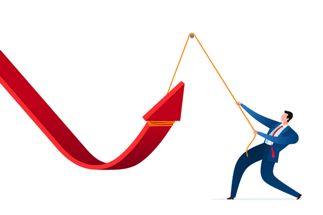 Regardless of what precipitates a recession, economic ebbs and flows are to be expected over time. Recessions can be caused by a period of contraction that inevitably comes after economic expansion or a sudden and unexpected economic shock.
Regardless of what precipitates a recession, economic ebbs and flows are to be expected over time. Recessions can be caused by a period of contraction that inevitably comes after economic expansion or a sudden and unexpected economic shock.
While the coronavirus recession is fresh on our minds, it is not the first nor will it be the last recession that today’s businesses face. Knowing how to weather a recession is an essential management skill regardless of how long it lasts. However, facing a prolonged recession poses unique challenges that can test even the most adept leaders.
Our team of experienced CFOs shares their top tips on getting through a recession and coming out stronger on the other side:
Remain Focused
Keep the company organized around your mission statement even while adapting to the recession:
“Pursue new business opportunities when they arise but do not lose focus on your core competencies. Resist the temptation to chase short-term revenue opportunities from non-complementary product or service offerings, which could pull the company in too many directions and dilute overall goals.”
Remember, adapting is a form of evolving, not changing gears entirely. Do not forget who you serve. Your customers are the reason your business exists, without them you will not have a business.
Be Informed
If remaining focused is about knowing who you are, being informed is about knowing where you are.
Know what is going on in the market and within your organization as well. Regularly assess the health of your business using KPIs and other valuable metrics. Lean on the data to understand how well your company is doing respective to the rest of the industry. Rely on forecasting and understand where spend is relative to budgets to stay on top of cash flow management.
Freely share key information within the organization as well to assuage employees’ concerns. Be transparent with staff to encourage honest communications and build trust. Laying this foundation is critical to retaining top employees.
Stay Agile
Use the performance data that you have acquired to make smart cash-related decisions. Strategically manage costs instead of simply cutting them by:
- Delaying major asset purchases or long-term investments
- Shrinking nonessential spending in areas where it will not affect revenue generation
- Looking for ways to reduce waste or operating inefficiencies to improve profitability
- Negotiating discounts or more favorable payment terms from suppliers, contractors, and landlords
- Leaning out inventory to avoid tying up cash in slow-moving inventory
Instead, use cash to meet critical business needs. Liquidity will be key for not only maintaining business operations, but also securing financing if the company decides to seek funding externally in the future.
Improve your Team
Use cash flow wisely to hire and train up employees. Be optimistic in your management – look forward to the future when it comes to recruiting new employees and managing current employees.
Continue hiring additional employees to ensure the business will be able to serve its customers effectively. Talk to managers to determine how much capacity employees have and hire strategically to avoid overloading current employees. When cash flow is tight, consider hiring externally to bring in more help without the carrying cost of full-time employee benefits. A Small Business Association resource advises, “Options include freelancers, consultants and part-time employees. One advantage of a slowdown is that hiring gets easier because there are more candidates from which to choose due to layoffs and other cutbacks.”
Keep funding job-related training for current employees to broaden their skillsets and provide additional perspectives. “Level up” key management roles that will be critical to keep the company afloat during the downturn and drive it forward once the economy starts to rebound. For example, train and transition your controller role to a CFO role to provide stronger financial leadership that requires greater experience. Manage up existing staff or hire externally to get the right talent into leadership roles so the company is ready to capitalize on opportunities as they arise.
Finally, meet current employees where they are – providing care for their physical and mental health in the face of uncertainty and offering them the flexibility that they need to do their best work amid personal barriers.
Continue to Adapt
A prolonged recession is different than a sudden brief disruption from a managerial standpoint. Lengthy recessions require ongoing moves and countermoves across the organization to weather it successfully. Continuously prune offerings to reduce or eliminate lower margin products/services and remain open to the idea of developing new markets if it makes strategic sense to do so.
Embody a cycle of planning, executing, and evaluating with every change you make to determine if business pivots are helping or hurting the company’s financial position. Long recessions have lots of bumps and curves along the road – regularly gauge where the business is and where it is going to stay on the right track as you continue to adapt.
Be Prepared
This recession is not the first and it will not be the last. As the old joke goes, “The only certainty in business is uncertainty.”
Of course, being ready for a recession is not something you can do after it has already hit, which is why planning is so critical. Keep your eyes and ears open now to gain a deep understanding of how the recession is challenging your business to be better prepared the next time around. Lastly, consult with or hire the right financial personnel now to be prepared for whatever the future may hold.
Let us help you find the right CFO to lead your business through any storm.





